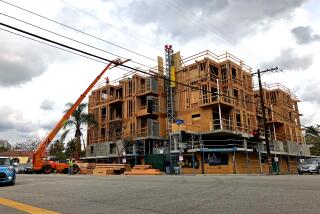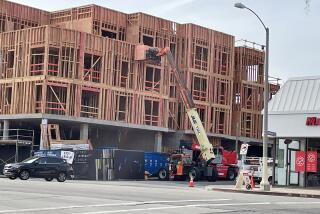Campaign to Enforce Minimum Size on Lots for Single-Family Homes Heats Up
- Share via
CORONA — A campaign to enforce a minimum size for single-family residential lots went into full swing this week as a group of Corona residents, including a current and a former city councilman, began circulating initiative petitions.
The proposed ordinance, supported by a group calling itself the Corona Registered Voters Assn., would require city officials to honor Corona’s general land-use plan, which calls for lots of at least 7,200 square feet, said William Franklin, mayor pro tem and leader of the drive.
According to Franklin, Corona’s developers and City Council have enacted “specific plans” as a legal loophole to allow thousands of single-family homes on lots as small as 3,200 square feet.
“That results in overcrowding,” Franklin said. “It’s difficult to plan for. The whole city’s infrastructure will be insufficient.”
The lot-size issue was central to Franklin’s 1984 election campaign, but he has been unable to persuade his council colleagues to reject plans for what he calls “substandard homes.” So Franklin and 10 other Corona residents, including Louis E. Keller, who served on the City Council from 1962 to 1966, organized the association.
Councilman William Miller said, “I think that, obviously, Mr. Franklin is in the minority, or he wouldn’t need his initiative. . . . If the council were blatant in approving trash, then I could see it. But I don’t think the community as a whole sees the development that has been taking place in Corona that way. . . .
“Which development has the citizens screaming that the City Council fouled up?” Miller asked. “I haven’t seen it. . . . The people elected the majority of the council, knowing what our position on growth is.”
The initiative differs substantially from the more restrictive residential zoning laws in neighboring Norco, where homes generally must sit on lots of at least 20,000 square feet.
Norco generally does not allow multiple dwellings. Even proponents of the initiative agree that the Corona area faces a shortage of rental housing and needs to encourage more such developments.
Concerns Cited
The Corona group’s petitions claim that excessively dense single-family housing development, however, “if allowed to continue, could cause conditions harmful to the public health, safety and general welfare and may result in the overcrowding of schools, deteriorating water quality and sewage treatment capacity, inadequate police and fire protection (and) inadequate parks and recreation facilities. . . .”
But Miller countered that “new residents pay their own way” through development fees and special assessments. Any potential problems, he said, stem not from growth but from “lack of supervision of growth.”
Franklin’s group must collect 2,833 signatures--15% of Corona’s 18,881 registered voters--to force the City Council either to enact an ordinance or to put the issue to voters in a special election, said Barbara Myers, a spokeswoman for the Riverside County registrar of voters.
A special election, which would be held about three months after the petitions were presented to the council for action, would cost the city about $30,000, Myers estimated.
If the initiative’s backers fail to garner the required 15% support, but do collect signatures from 10% of the city’s voters, the council still would be required either to approve the ordinance or to place it on the ballot, Myers said. But the city could wait until the next regular election--in November, 1986.
Under state law, a city’s development is guided by its “general plan,” in which the city maps out the types of land uses it will allow in various parts of the city. The general plan is reflected, in turn, in the city’s zoning.
“In practice, there is no general plan for single-family residential development in the city of Corona, and there has not been a general plan for several years,” the initiative petition charges. “Instead, the city is using specific plans . . . to disregard the general plan and create new rules for construction.”
A specific plan is used to “implement (the) general plan for a special area,” said Anne Thomas, a Corona city attorney in the Riverside firm of Best, Best & Krieger. It can, she said, “replace the underlying zoning.”
But state law requires that a specific plan, like zoning, be consistent with the city’s general plan, Thomas said. “What (a specific plan) is generally used for is to give you a panoramic view” of a residential development--the planned streets, public improvements and other features, in addition to the houses.
While some features--open space areas, for example--can be used to offset smaller lot sizes, she said, Corona must “maintain the overall density at (one house per) 7,200 square feet” in its single-family, residential areas.
Members of the Corona Registered Voters Assn., however, say the City Council has failed to do just that. “For the last four years,” Franklin said, the council has “put into effect every substandard proposal that has been presented to them in the single-family area. . . .
“We firmly believe that the substandard homes will be slums within a reasonably fast period of time,” he said.
“Whatever price you are talking about, they will be starter homes for people, instead of homes that people will stay in and be proud of. . . . (They) will be dominated by landlords and renters, rather than homeowners.”
There is “plenty of money, plenty of demand” for middle- and upper-class homes in Southern California, Franklin said. “And I think Corona has done its fair share for the creation of starter homes.”
Too many small lots will depress property values in Corona, Franklin said. “We must have a growth policy that the people can depend upon because most of us are investing our life savings in Corona property.”
But Miller said the size of a lot does not determine the quality of the home built there, and he cited Mission Viejo and Anaheim Hills as examples of areas where high-quality homes have been built on relatively small lots.
Miller added that he would “be happy to work on an architectural review . . . side by side with Bill Franklin.”
Besides restricting residential lot size, the initiative also seeks to prohibit Corona from supporting or giving “financial subsistence of any kind” to plans for an automobile race track near Prado Dam. Residents near the track would suffer from noise, air pollution and traffic if the Riverside International Raceway moved to Corona, the petition states.
But raceway officials in April abandoned their proposal to move the track to Corona.
Opponents of the initiative suggest that the provision opposing raceway development is a red herring designed to gain support from people who may, wrongly, still fear that a track might be built near their homes.
“That’s over, as far as I can see,” said Miller, who had supported the proposed move because of the track’s potential to attract economic development in automotive and engineering fields.
“There’s been no discussion of (bringing the raceway to Corona) for a few months,” the councilman said. “I can’t explain the race track hysteria. . . . To me, it’s a dead issue.”
Franklin said, however, that he believes “there are people in the community that are continuing to work for establishing the raceway at the Corona site.”
Another provision of the proposed ordinance would require the city to give neighbors 14 days’ notice before a vote on a declaration that a project near their properties would have no significant environmental impact.
The ordinance also would require the City Council to hold biennial public hearings on ballot questions related to growth, far enough in advance of council elections to allow residents time to use the initiative process to put additional questions to a vote at the same time.
More to Read
Sign up for Essential California
The most important California stories and recommendations in your inbox every morning.
You may occasionally receive promotional content from the Los Angeles Times.









